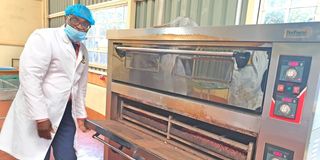I make butter, where are peanut farmers?

Jackson Masesi at his groundnuts processing plant in Kilimambogo. He makes three varieties of peanut products; one blended with honey, another pure while the third one is crunchy.
What you need to know:
- Jackson Masesi, who runs Bee-Care Apiaries Limited makes three varieties of peanut products; one blended with honey, another pure while the third one crunchy.
- The whole process starts with separating quality peanuts from impurities such as leaves, pieces of shells and rotten nuts.
- To avoid aflatoxin, Karuiru advises farmers to ensure the nuts have minimal exposure to moisture by drying them well under the sun after harvesting.
- MARKUP project national coordinator Maina Karuiru says farmers need to know the benefits of quality production, for better produce and higher earning.
It is a hot afternoon as I venture in Magogoni, along the Thika-Ngoliba Road.
My destination is in Kilimambogo town, in search of Jackson Masesi, who runs Bee-Care Apiaries Limited.
Inside the start-up, one can easily pick out groundnut peels, giving an indication of what Masesi does.
“We process honey as well as peanut butter blended with the produce,” says Masesi, having read my mind after seeing me check out his business name.
“For about five years, we had specialised in production of bee-related equipment, honey processing and beewax for export. But I always found myself with excess honey, what made me venture into making peanut butter blended with honey,” explains Masesi.
He makes three varieties of peanut products; one blended with honey, another pure while the third one crunchy.
The whole process starts with separating quality peanuts from impurities such as leaves, pieces of shells and rotten nuts.
The clean nuts are then put into a roasting machine, where they are roasted at 2000C for between 30-45 minutes, with regular turning to ensure evenness.
The roasted nuts are then poured into a peeler, where the outer cover is removed.
Blended with honey
“We sell the waste to animal feeds manufacturers who use them as an ingredient in making pig, poultry and other livestock feeds.”
The next process is sorting, which involves removing the nuts which for some reason did not peel, and those that may have internal deformities like rotting or pest damage.
The clean nuts are then put into a miller, where they are milled to produce plain peanut butter, ready for packaging.
Some of the milled nuts are blended with honey and others mixed with ground nuts to produce peanut butter with honey and the crunchy product respectively. The products are certified by the Kenya Bureau of Standards.
“I first processed 300 kilos of peanuts as a test but demand has been rising. I now need between three and four tonnes of groundnuts every month.”
However, he only gets about 10 per cent of the nuts, mostly from Busia, while he is forced to import from Tanzania and Malawi.
“I am hoping to partner with a European Union (EU) funded project, dubbed Market Access Upgrade Program (MARKUP) implemented by United Nations Industrial Development Organisation, in partnership with the government and private sector, to be able to get quality groundnuts from farmers,” says Masesi, noting the EU is working with farmers to produce the quality nuts.
Lower fat content
So what kind of groundnuts is he looking for? “I process a variety known as Malawi and is locally referred to as the large red variety. It has a lower fat content compared to others,” says Masesi, adding a 90kg bag is bought at between Sh15,000 and Sh18,000.
The firm’s food safety and standards manager Wycliffe Nyakundi says once the nuts arrive at the factory, they are tested for moisture and aflatoxin.
“The moisture level must be below seven per cent, while the aflatoxin level not more than 15 parts per billion (ppb),” says Nyakundi, adding they should also not have foreign content or be rotten.
MARKUP project national coordinator Maina Karuiru says farmers need to know the benefits of quality production, for better produce and higher earning.
“Quality production should always be observed for produce which ends up in the local as well as international markets,” he says, noting they will train farmers on producing quality nuts, as well as linking them with markets.
To avoid aflatoxin, Karuiru advises farmers to ensure the nuts have minimal exposure to moisture by drying them well under the sun after harvesting.
Also, by storing them under dry conditions to ensure they don’t rot and separating the rotten ones from quality ones so that the entire produce is not affected.





